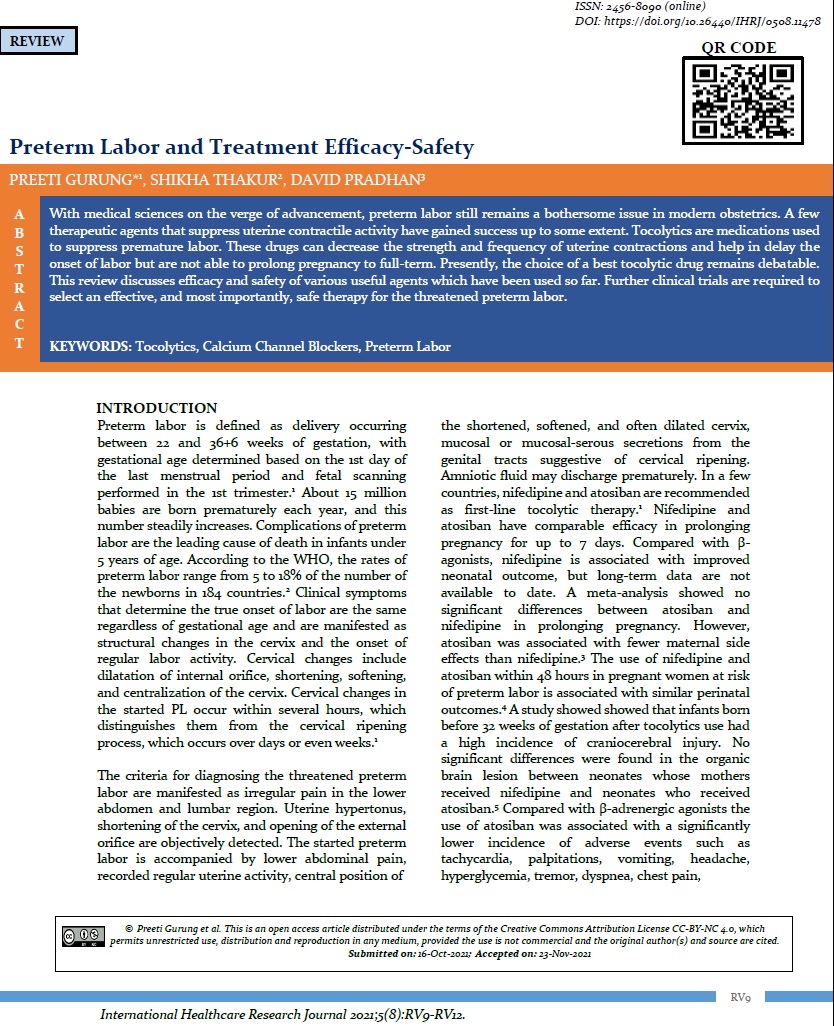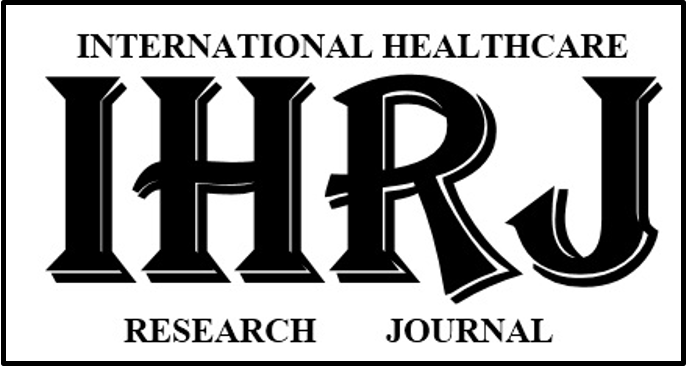Preterm Labor and Treatment Efficacy-Safety
Abstract
With medical sciences on the verge of advancement, preterm labor still remains a bothersome issue in modern obstetrics. A few therapeutic agents that suppress uterine contractile activity have gained success up to some extent. Tocolytics are medications used to suppress premature labor. These drugs can decrease the strength and frequency of uterine contractions and help in delay the onset of labor but are not able to prolong pregnancy to full-term. Presently, the choice of a best tocolytic drug remains debatable. This review discusses efficacy and safety of various useful agents which have been used so far. Further clinical trials are required to select an effective, and most importantly, safe therapy for the threatened preterm labor.
Downloads
References
Khodzhaeva ZS, Shmakov RG, Adamyan LV et al. Clinical recommendations. Preterm birth. М.; 2020. 42 p.
Vogel JP, Chawanpaiboon S, Moller AB, Watananirun K, Bonet M, Lumbiganon P. The global epidemiology of preterm birth. Best Pract. Res Clin Obstet Gynaecol 2018; 52: 3-12.
Ali AA, Sayed AK, El Sherif L, Loutfi GO, Ahmed AMM, Mohamed HB et al. Systematic review and meta-analysis of randomized controlled trials of atosiban versus nifedipine for inhibition of preterm labor. Int. J. Gynaecol Obstet 2019; 145(2): 139-48.
van Vliet EOG, Nijman TAJ, Schuit E, Heida KY, Opmeer BC, Kok M et al. Nifedipine versus atosiban for threatened preterm birth (APOSTEL III): a multicentre, randomised controlled trial. Lancet. 2016; 387(10033): 2117-24.
Nijman TAJ, Goedhart MM, Naaktgeboren CN, de Haan TR, Vijlbrief DC, Mol BW, et al. Effect of nifedipine and atosiban on perinatal brain injury: secondary analysis of the APOSTEL-III trial. Ultrasound Obstet. Gynecol. 2018; 51(6): 806-12.
Wex J, Connolly M, Rath W. Atosiban versus betamimetics in the treatment of preterm labour in Germany: an economic evaluation. BMC Pregnancy Childbirth. 2009; 9: 23.
Belousova VS, Strizhakov AN, Timokhina EV, Bogomazova IM, Pitskhelauri EG, Emelyanova ES. Premature birth: how to manage tocolysis? Obstetrics and gynecology. 2019; 6:102-7.
Valdes E, Salinas H, Toledo V, Lattes K, Cuellar E, Perucca E et al. Nifedipine versus fenoterol in the management of preterm labor: a randomized, multicenter clinical study. Gynecol. Obstet. Invest. 2012; 74(2): 109-15.
Leal-Junior CC, Amorim MMR, Souza GFA, Lima AKS, Souza ASR. Effectiveness of an oral versus sublingual loading dose of nifedipine for tocolysis. Int J.Gynaecol Obstet 2020; 148(3): 310-5.
Maher MA, Sayyed TM, El-Khadry SW. Nifedipine alone or combined with sildenafil citrate for management of threatened preterm labour: a randomised trial. BJOG. 2019; 126(6): 729-35.
Padovani TR, Guyatt G, Lopes LC. Nifedipine versus terbutaline, tocolytic effectiveness and maternal and neonatal adverse effects: a randomized, controlled pilot trial. Basic Clin Pharmacol Toxicol 2015; 116(3): 244-50.
Xu YJ, Ran LM, Zhai SS, Luo XH, Zhang YY, Zhou ZY et al. Evaluation of the efficacy of atosiban in pregnant women with threatened preterm labor associated with assisted reproductive technology. Eur Rev Med Pharmacol Sci 2016; 20(9): 1881-7.
Rezk M, Sayyed T, Masood A, Dawood R. Nicorandil vs nifedipine for the treatment of preterm labour: a randomized clinical trial. Eur J Obstet Gynecol Reprod Biol 2015; 195: 27-30
Haas DM, Caldwell DM, Kirkpatrick P, McIntosh JJ, Welton NJ. Tocolytic therapy for preterm delivery: systematic review and network meta-analysis. BMJ. 2012; 345: e6226.
Suhag A, Saccone G, Berghella V. Vaginal progesterone for maintenance tocolysis: a systematic review and meta-analysis of randomized trials. Am J Obstet Gynecol 2015; 213(4): 479-87.
Areia A, Fonseca E, Moura P. Progesterone use after successful treatment of threatened pre-term delivery. J Obstet Gynaecol 2013; 33(7): 678-81.
Saccone G, Suhag A, Berghella V. 17-alpha-hydroxyprogesterone caproate for maintenance tocolysis: a systematic review and metaanalysis of randomized trials. Am J Obstet Gynecol 2015; 213(1):
-22.
Rozenberg P, Chauveaud A, Deruelle P, Capelle M, Winer N et al; Groupe De Recherche En Obstétrique et Gynécologie. Prevention of preterm delivery after successful tocolysis in preterm labor by 17 alpha-hydroxyprogesterone caproate: a randomized controlled trial. Am J Obstet Gynecol. 2012 Mar;206(3):206.e1-9.
Aggarwal A, Bagga R, Girish B, Kalra J, Kumar P. Effect of maintenance tocolysis with nifedipine in established preterm labour on pregnancy prolongation and neonatal outcome. J Obstet Gynaecol 2018; 38(2): 177-84.
Kamat S, Veena P, Rani R. Comparison of nifedipine and progesterone for maintenance tocolysis after arrested preterm labour. J Obstet Gynaecol 2014;34(4): 322-5.
Choudhary M, Suneja A, Vaid NB, Guleria K, Faridi MM. Maintenance tocolysis with oral micronized progesterone for prevention of preterm birth after arrested preterm labor. Int J Gynaecol Obstet. 2014; 126(1): 60-3.
Palacio M, Ronzoni S, Sбnchez-Ramos L, Murphy KE. Progestogens as maintenance treatment in arrested preterm labor: a systematic review and metaanalysis. Obstet. Gynecol. 2016; 128(5): 989-1000.
Wood S, Rabi Y, Tang S, Brant R, Ross S. Progesterone in women with arrested premature labor, a report of a randomised clinical trial and updated meta-analysis. BMC Pregnancy Childbirth. 2017; 17(1):258.



